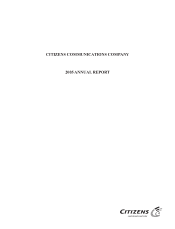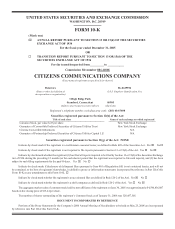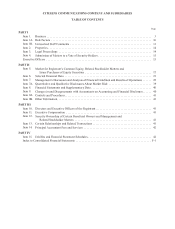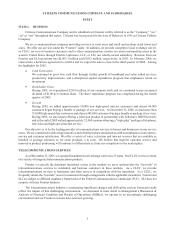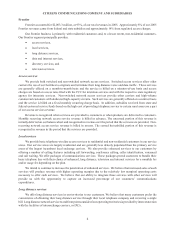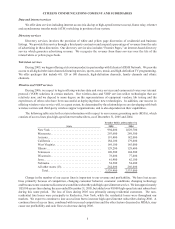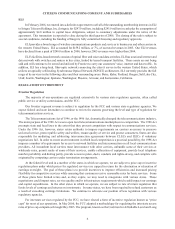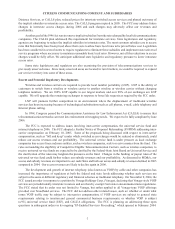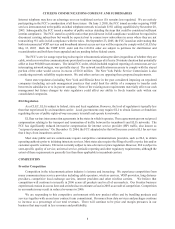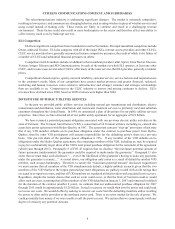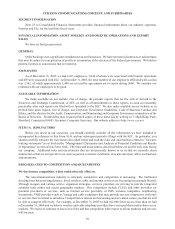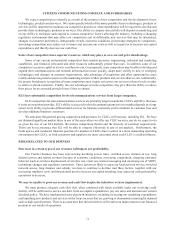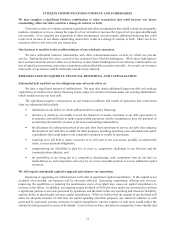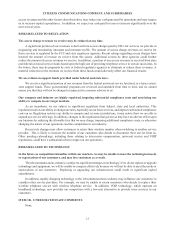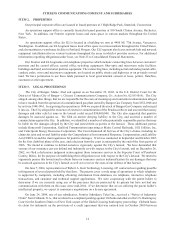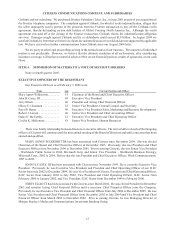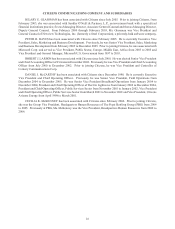Frontier Communications 2005 Annual Report Download - page 8
Download and view the complete annual report
Please find page 8 of the 2005 Frontier Communications annual report below. You can navigate through the pages in the report by either clicking on the pages listed below, or by using the keyword search tool below to find specific information within the annual report.6
CITIZENS COMMUNICATIONS COMPANY AND SUBSIDIARIES
ELI
In February 2006, we entered into a definitive agreement to sell all of the outstanding membership interests in ELI
to Integra Telecom Holdings, Inc. (Integra), for $247.0 million, including $243.0 million in cash plus the assumption of
approximately $4.0 million in capital lease obligations, subject to customary adjustments under the terms of the
agreement. This transaction is expected to close during the third quarter of 2006. The closing of the sale is subject to
several conditions, including the funding of Integra’s fully committed financing and regulatory approvals.
ELI provides a broad range of wireline communications products and services to businesses and other carriers in
the western United States. ELI accounted for $159.2 million, or 7%, of our total revenues in 2005. Our ELI revenues
have declined from a peak of $240.8 million in 2000, however 2005 revenues were higher than 2004.
ELI’s facilities-based network consists of optical fiber and voice and data switches. ELI has a national internet and
data network with switches and routers in key cities, linked by leased transport facilities. These assets are not being
sold and will continue to be owned and utilized by Frontier to carry our customers’ voice, internet and data traffic. In
addition, ELI has a long-haul, fiber-optic network connecting the cities it serves in the western United States, which
utilizes an optically self-healing Synchronous Optical Network (SONET) architecture. ELI currently provides the full
range of its services in the following cities and their surrounding areas: Boise, Idaho; Portland, Oregon; Salt Lake City,
Utah; Seattle, Washington; Spokane, Washington; Phoenix, Arizona; and Sacramento, California.
REGULATORY ENVIRONMENT
Frontier Regulation
The majority of our operations are regulated extensively by various state regulatory agencies, often called
public service or utility commissions, and the FCC.
Our Frontier segment revenue is subject to regulation by the FCC and various state regulatory agencies. We
expect federal and state lawmakers to continue to review the statutes governing the level and type of regulation for
telecommunications services.
The Telecommunications Act of 1996, or the 1996 Act, dramatically changed the telecommunications industry.
The main purpose of the 1996 Act was to open local telecommunications marketplaces to competition. The 1996 Act
preempts state and local laws to the extent that they prevent competition with respect to communications services.
Under the 1996 Act, however, states retain authority to impose requirements on carriers necessary to preserve
universal service, protect public safety and welfare, ensure quality of service and protect consumers. States are also
responsible for mediating and arbitrating interconnection agreements between CLECs and ILECs if voluntary
negotiations fail. In order to create an environment in which local competition is a practical possibility, the 1996 Act
imposes a number of requirements for access to network facilities and interconnection on all local communications
providers. All incumbent local carriers must interconnect with other carriers, unbundle some of their services at
wholesale rates, permit resale of some of their services, enable collocation of equipment, provide local telephone
number portability and dialing parity, provide access to poles, ducts, conduits and rights-of-way, and complete calls
originated by competing carriers under termination arrangements.
At the federal level and in a number of the states in which we operate, we are subject to price cap or incentive
regulation plans under which prices for regulated services are capped in return for the elimination or relaxation of
earnings oversight. The goal of these plans is to provide incentives to improve efficiencies and increased pricing
flexibility for competitive services while ensuring that customers receive reasonable rates for basic services. Some
of these plans have limited terms and, as they expire, we may need to renegotiate with various states. These
negotiations could impact rates, service quality and/or infrastructure requirements which could impact our earnings
and capital expenditures. In the other states in which we operate, we are subject to rate of return regulation that
limits levels of earnings and returns on investments. In some states, we have been required to refund customers as
a result of exceeding earnings limitations. We continue to advocate our position of less regulation with various
regulatory agencies.
For interstate services regulated by the FCC, we have elected a form of incentive regulation known as “price
caps” for most of our operations. In May 2000, the FCC adopted a methodology for regulating the interstate access
rates of price cap companies through May 2005. The program, known as the Coalition for Affordable Local and Long

